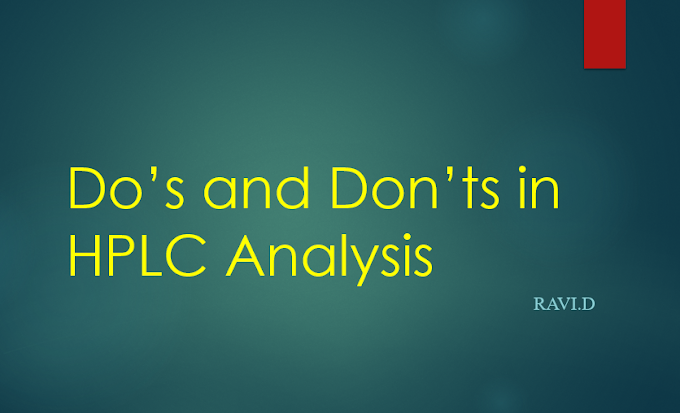Introduction:
Analytical
method development for HPLC analysis is a very critical process in all the
industries. The selection of column, mobile phase, pH of mobile phase,
selection on sample solvent and selection of instrument parameters considered
as a critical process in method development.
A good
analytical method should be simple, precise and should reproduce results. It
can be done easily step by step.
2.
Selection of Chromatographic Conditions
3.
Optimization of the Selected Parameters
Always try to keep the method simple, try common columns and simple mobile phase and stationary phase.
1.Selection on HPLC method:
Before start developing the method understand the nature of the product. Literature study of the compound that you’re going to develop is very important. It will help you to understand the product and when you come to know the previous work on the compound, will save time and no need to do the unnecessary experiments. Once if we get and basic knowledge and idea about the analytical method, then we can optimize the operational conditions for our requirements for the regular use and can be validated.
1.1 Solvent Selection and Sample Preparation:
Select the sample solvent based on the solubility of the compound. Filtration of the sample or further extraction required for sample preparation and special requirements or precautions should be clear.
For most of the sample analysis Reverse Phase will be used. Ion suppression or Ion pair chromatography can be used when the sample contains weak acid/base and Strong acid/base.
The stationary phase should be C18 bonded.
Normal phase can be used for low or medium polarity samples. Normal phase used to separate the isomers.
If sample contains inorganic anion or cation, Ion exchange chromatography will be suitable.
If interested
compound having higher molecular weight, then size exclusion chromatography cab
be used.
1.3 Gradient or Isocratic Mode:
When the sample contains the mixture of compounds, gradient HPLC method is suitable to separate.
Also Compared to Isocratic, Gradient gives a higher resolution by adjusting the gradient program. Gradient HPLC having higher sensitivity especially for the products which is having higher retention time.
1.4 Column Size Particle Size:
Mostly 100 to 150mm size columns will be used for most of the samples. It reduces analysis time as well as the method development time. When the sample is very complex and contains more analytes, bigger size columns can be used.
1.5 Wavelength:
λ max of the sample has the greatest sensitivity to the UV light. It detects the compounds have Chromophores. Wavelength above 200nm gives greater sensitivity than the lower wavelengths. Because less than 200nm gives more noise. When more than one compound separated in the single run, then the wavelength can be optimized for both the compounds and validated the same.
1.6 Detector Selection:
If the sample contain chromophores, it can be detected by UV detectors. It is better to use UV detector than others.
If need to detect the traces , then Fluorescence and electrochemical detectors should be used.
Higher
concentration or Sugar compounds cab de analyzed by RI detectors.
2.Selection of Chromatographic Conditions:
After selection of the above parameters, different chromatographic conditions are selected like flow rate, temperature, pH of the mobile phase and the gradient program.
The flow
rate should be column dependent. The concentration of the solvent in the mobile
phase is used to determine the retention time. pH of the mobile phase and the
ion paring reagent used also affects the retention time. When the sample
contains more than one compounds, then gradient system can be used to avoid the
long run time and to get better resolution between compounds. Column temperature
also affects the peak shape and retention time.
3. Optimization of the Selected Parameters:
Flow rate,
particle size of the column, pH of the mobile phase, run time, temperature,
injection volume and gradient program can be optimized for the better
resolution and results.




0 Comments